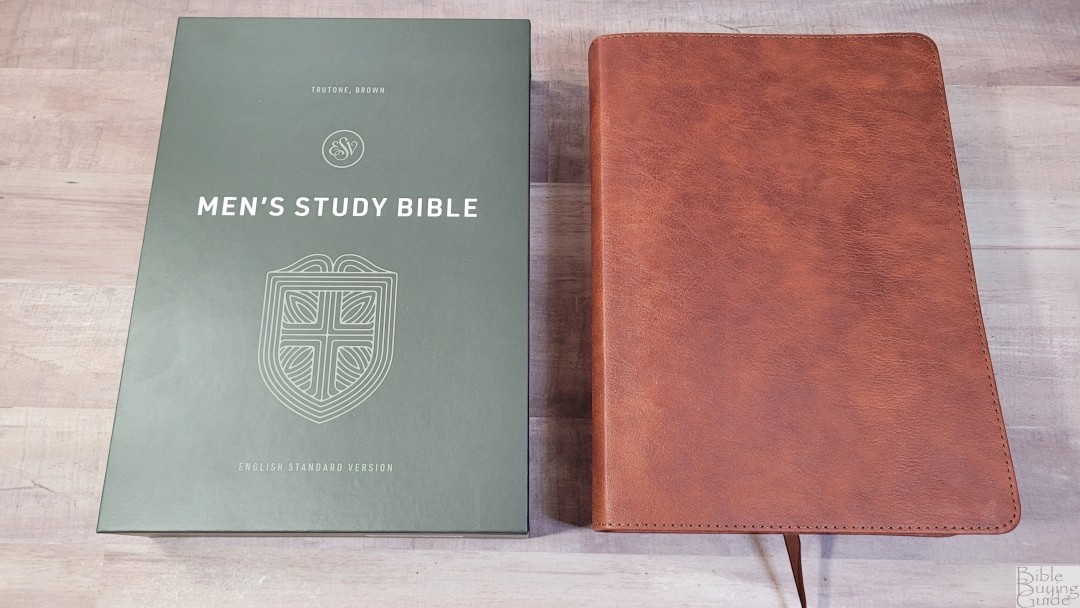
Crossway’s ESV Men’s Study Bible combines elements from the ESV Study Bible and the Men’s Devotional Bible to create a study Bible with basic theology and men’s issues. It includes study notes, devotionals, articles, and new content geared toward men’s topics with personal application. It’s available in hardcover and TruTone (imitation leather). I’m reviewing the brown TruTone, ISBN 9781433581632, made in China.
Crossway provided this Bible in exchange for an honest review. I was not required to give a positive review, only an honest one. All opinions are my own.
_________________________________________________________
This Bible is available at (includes some affiliate links)
and many local Bible bookstores
_________________________________________________________
Table of Contents
- Cover and Binding
- Paper
- Typography
- Footnotes and References
- Introductions
- Study Material
- Concordance
- Maps
- Conclusion
Cover and Binding
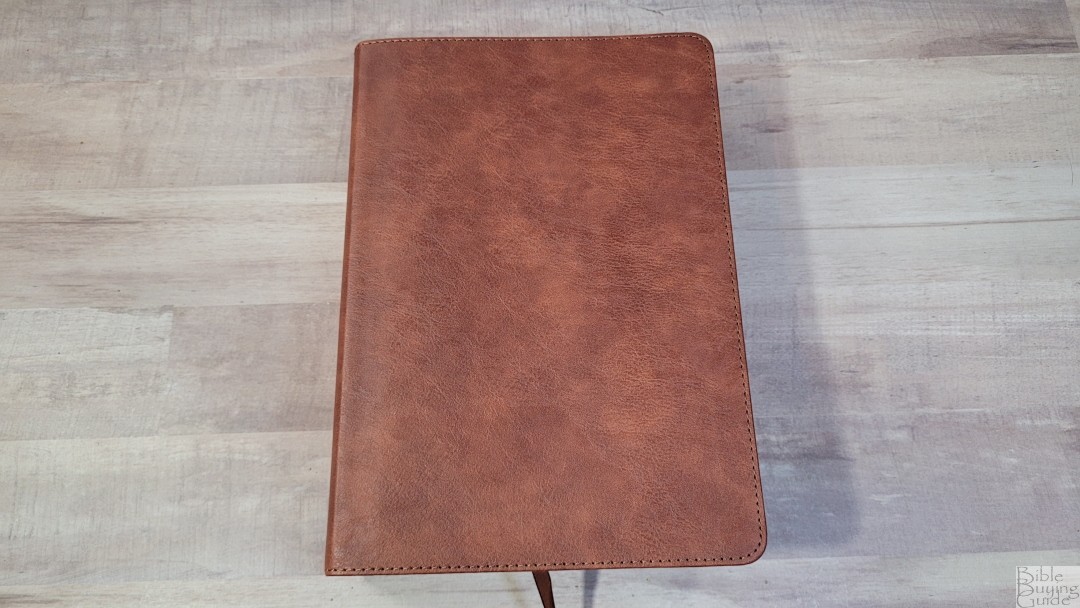
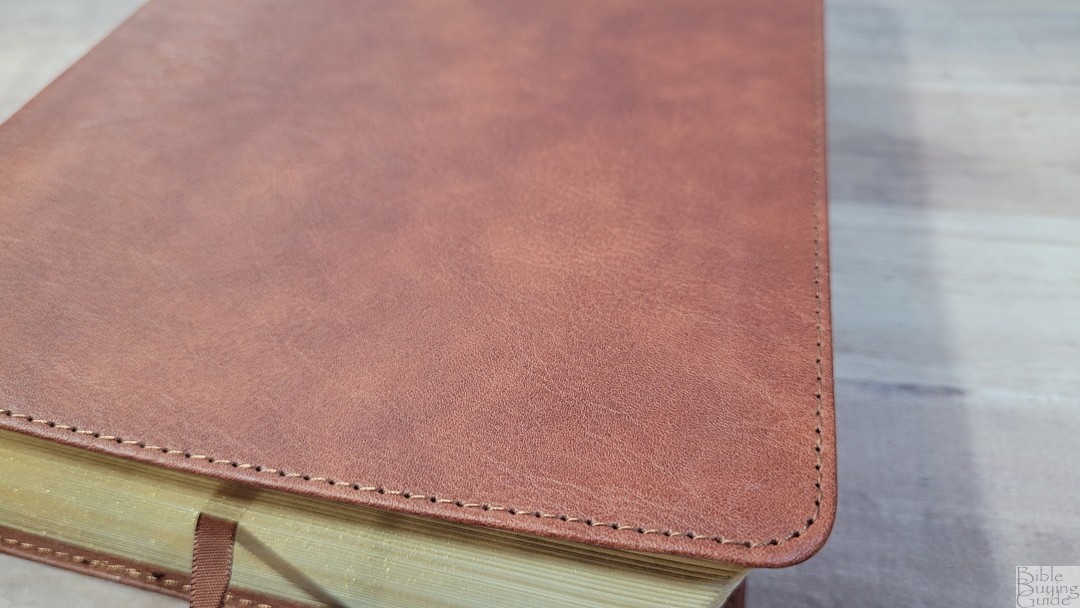
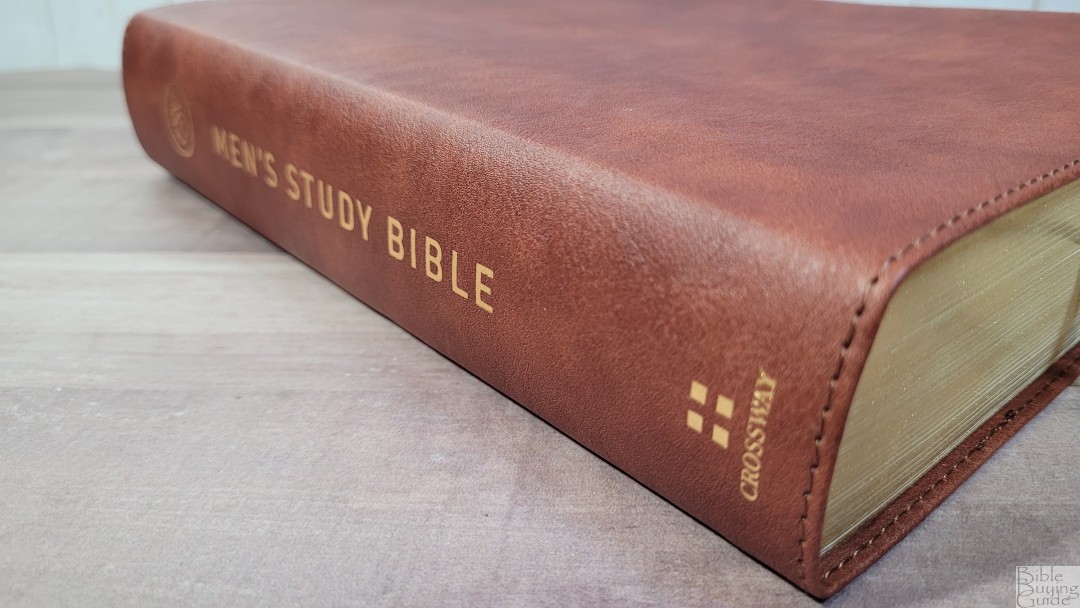
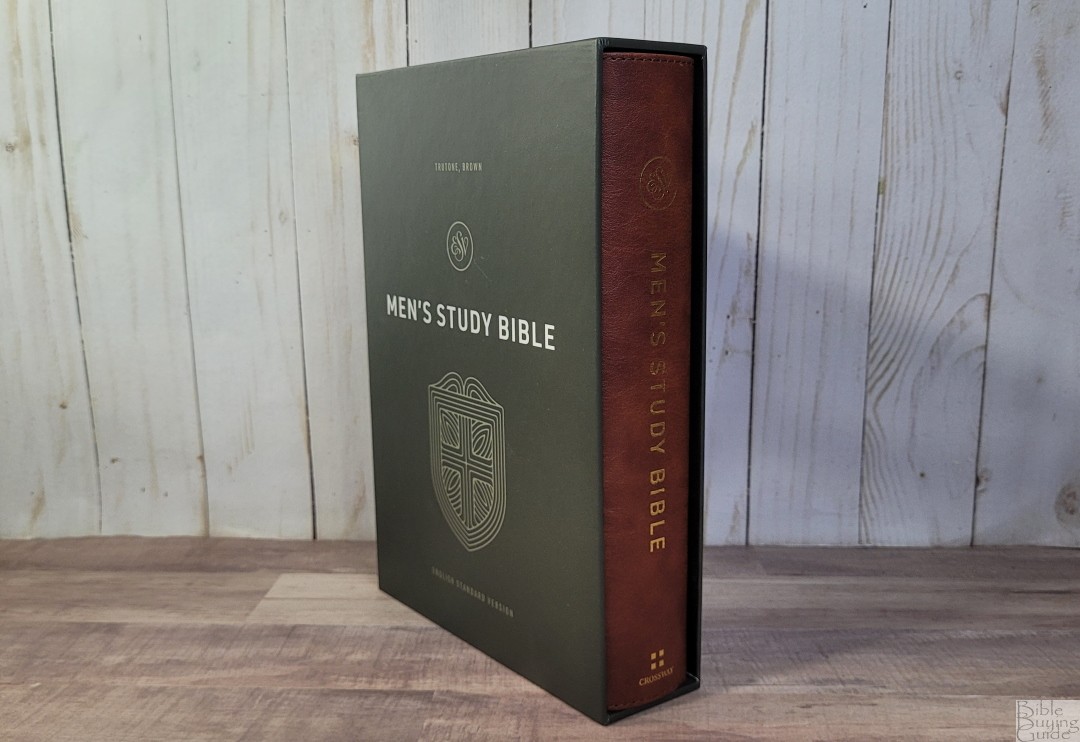
I chose the brown TruTone edition. It comes in a sturdy slipcase. The TruTone looks and feels similar to bonded leather. It does have grain and some brown color texture that draws me to it. It is stiff and keeps a bent shape when used. It includes parameter stitching with nothing printed on the front. The spine has text printed in gold with the title in a large font that’s printed horizontally so it can easily be read with the Bible sitting on a surface.
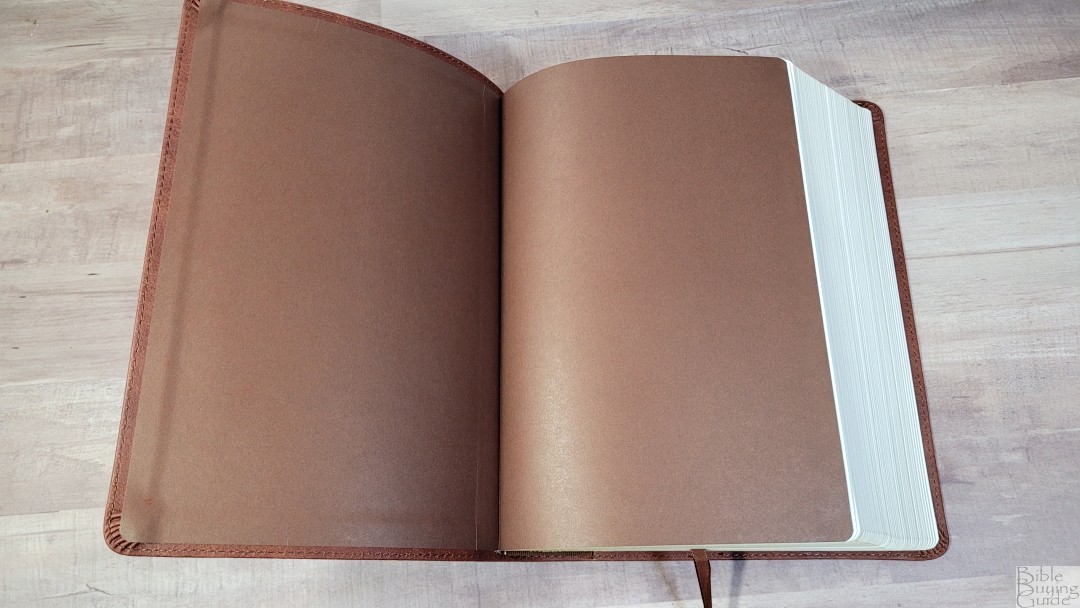
The liner is paste-down with brown coated paper. Surprisingly, it stays open perfectly. The text block is sewn and there are several thick end sheets in the front to give it structure.
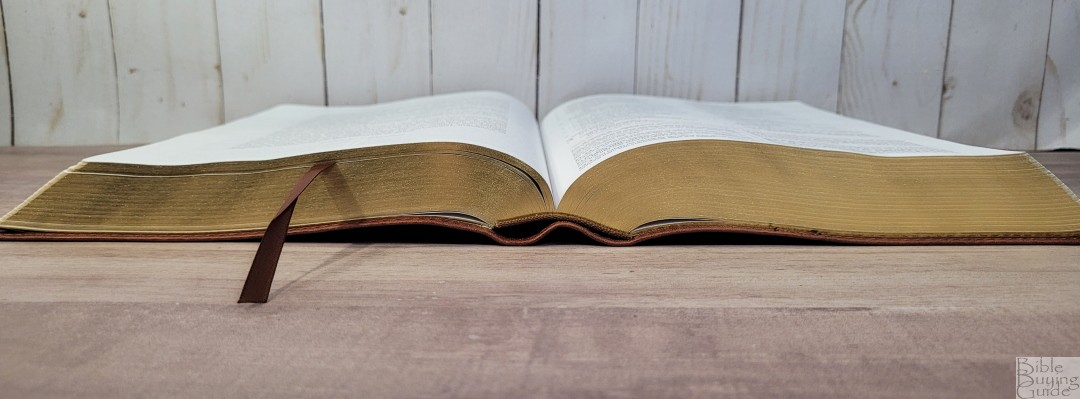
It has one 0.25″ brown ribbon that’s long enough to pull to the corner to open easily. The overall size is 6.5 x 9.5 x 4.76″ and it weighs 3 lbs, 0 oz.
Paper
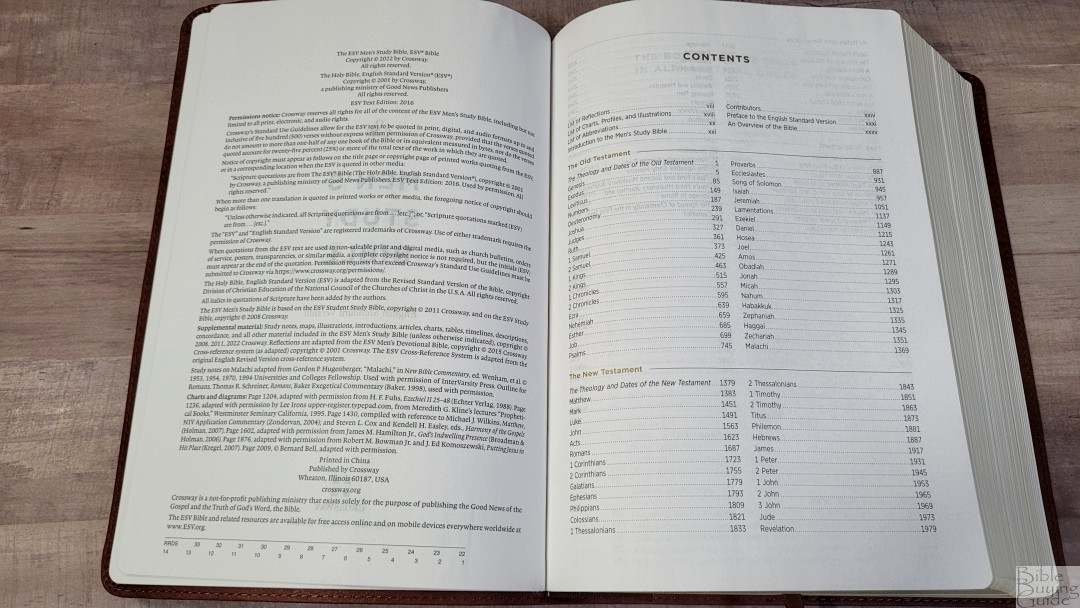
The paper is 30gsm Thin Opaque. It’s not premium paper, so it does not have a coating or extra pigment to reduce show-through. It has a slightly rough texture that helps when turning pages. The show-through is noticeable, but I didn’t find it too distracting. This is partially due to the medium-weight font. It’s white in color and has no glare under direct light. I think dry highlighters would work great, but I don’t think I’d try markers.
Typography
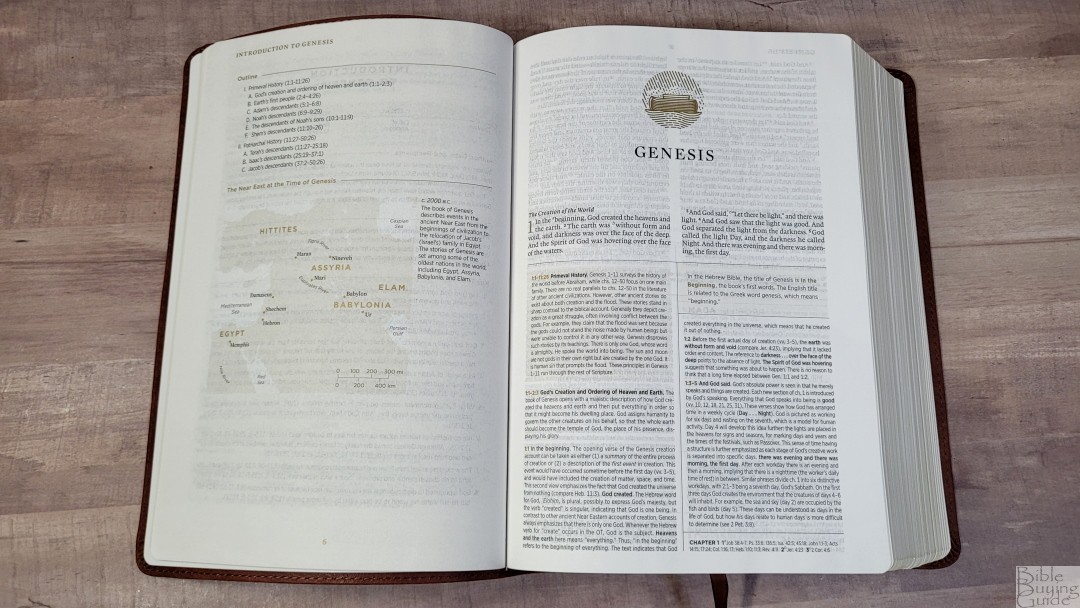
The 2016 text is set in the standard ESV double-column paragraph layout with poetry in stanzas. Footnotes are placed under the text while commentary is placed at the bottom of the page with cross-references under the last comment. Chapter numbers, header text, chapter and verse numbers in the commentary, and several other highlights are printed in gold. The header shows the page number in the center and the book name and reference in the outer margin. Each book includes a graphic above its title printed in gold.
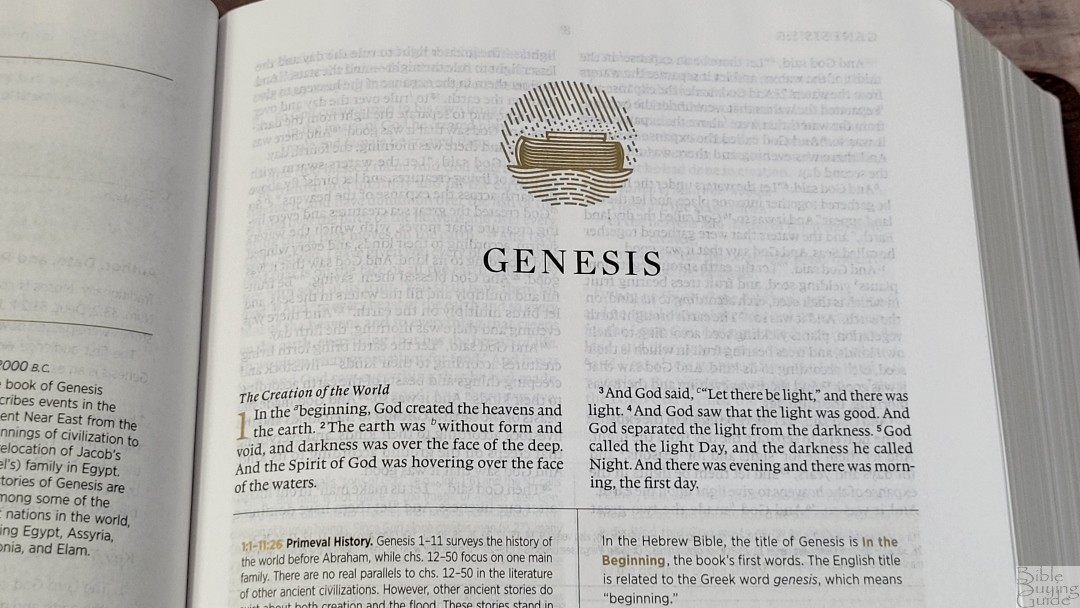
The font is 8 Lexicon. This is a medium-weight typeface with black letter. Aside from titles in the commentary, all other text is lightweight. I find the regular text easy enough to read, but the lightweight text is difficult for these older eyes. The print quality is consistent throughout. The text is not printed with line-matching, so there are some areas where the show-through is distracting. It’s mostly noticeable in the poetic setting.
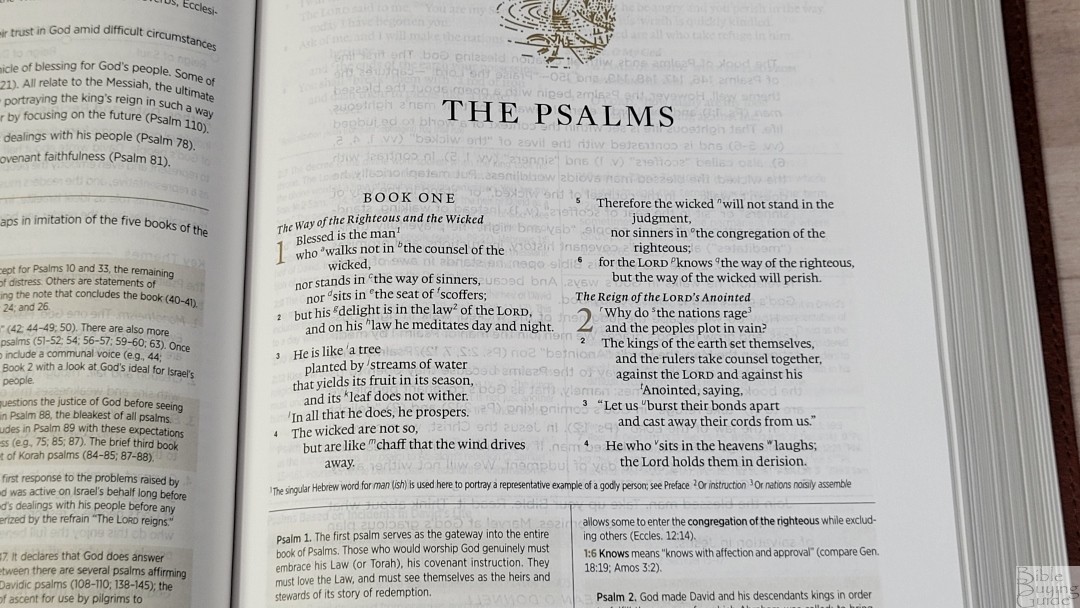
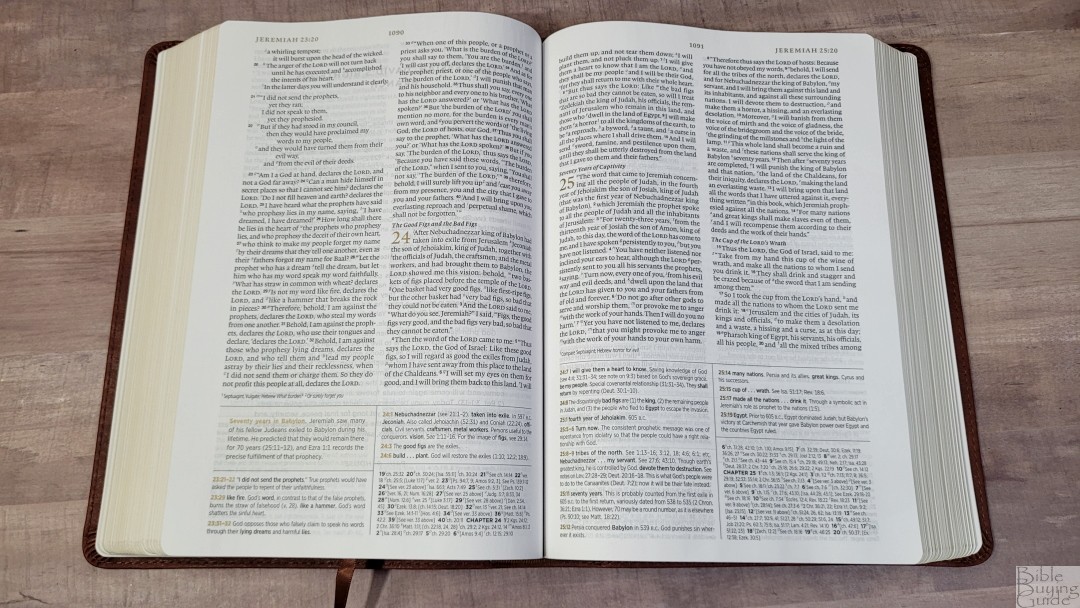
It has around 9-10 words per line with a good amount of space between the lines. This allows most of the poetic lines to look great. There are a few lines with a single word, but that’s to be expected when you have less than 14 words per line. Verse numbers are small, but they’re slightly darker than the text. They can still take an extra second or two to find. The layout has enough inner margin to bring the text out of the gutter. The outer margin is .75″, which is great for small notes.
Footnotes and References
Footnotes
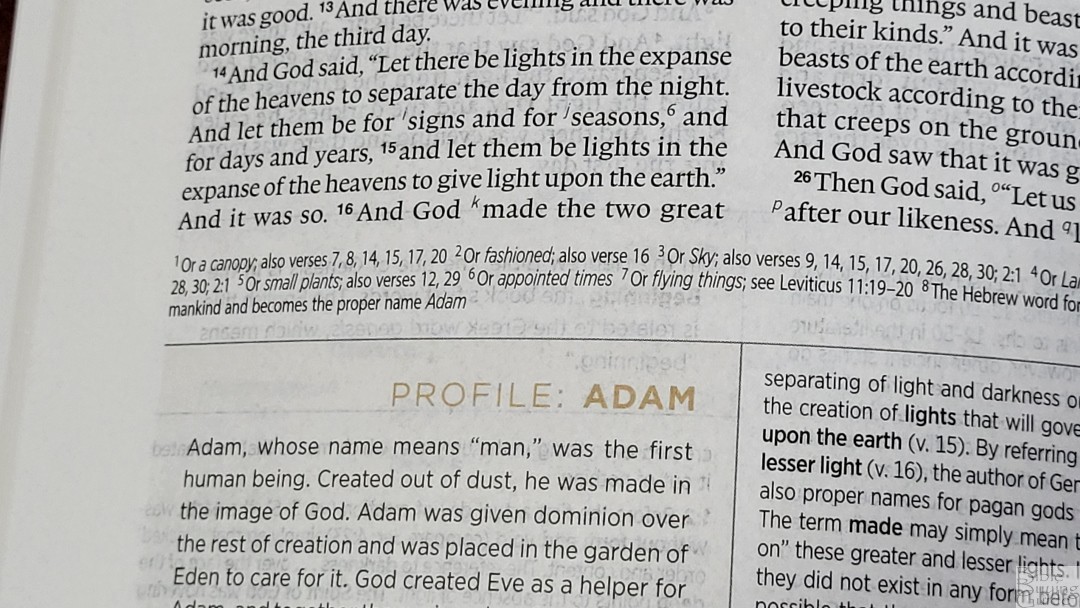
The ESV footnotes are under the text and separated from the commentary by a line and are keyed to the text with numbers. They include weights and measures, manuscript variants, parallel verses, where something was quoted from, alternate renderings, meanings of words, textual explanations, and more. I find them helpful in for reading and studying.
Cross References
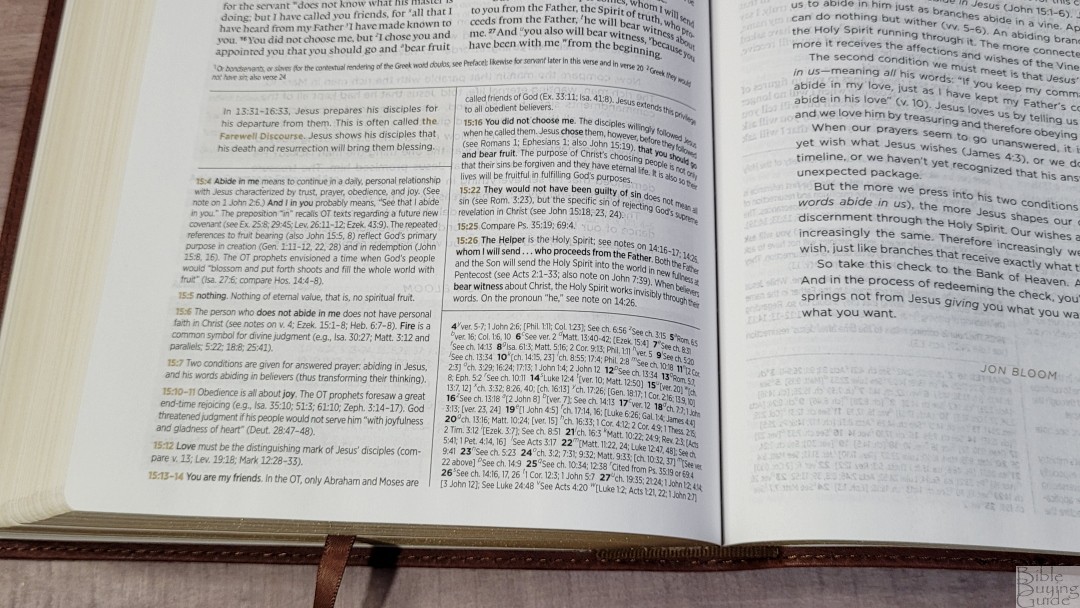
The ESV Men’s Study Bible includes the standard set of 80,000 ESV cross-references. They cover words and themes, making this an excellent Bible for personal study and sermon prep. Here are a few examples of references to help you compare:
Here are some example references to help you compare:
- Genesis 1:1 – Job 38:4-7; Ps 33:6; 136:5; Isa 42:5; 45:18; Jn 1:1-3; Ac 14:15; 17:24; Col 1:16, 17; Heb 1:10; 11:3; Rev 4:11
- Deuteronomy 6:4 – Cited Mk 12:29; Isa 42:8; Zech 14:9; Jn 17:3; 1 Cor 8:4, 6
- Isaiah 9:6 – Lk 2:11; Jn 3:16; ch 7:14; Mt 28:18; 1 Cor 15:25; ch 22:22; ch 28:29; ch 10:21; Deut 10:17; Neh 9:32; Jer 32:18; Ps 72:17; ch 63:16; Jn 14:18; Ps 72:7; Eph 2:14; see ch 1:6-9
- Matthew 28:19 – Mk 16:15, 16; ch 13:52; Lk 24:47; ch 24:14; Mk 11:17; Rom 1:5; Ac 8:16; 2 Cor 13:14
- Mark 12:29 – Lk 10:27; cited from Dt 6:4, 5; Rom 3:30; 1 Cor 8:4, 6; Gal 3:20; Eph 4:6; 1 Tim 1:17; 2:5; Jm 2:19; 4:12; Jude 25; Mt 19:17; 23:9
- John 1:1 – Gn 1:1; Col 1:17; 1 Jn 1:1; Rev 1:4, 8, 17; 3:14; 21:6; Rev 19:13; Heb 4:12; 1 Jn 1:1; 1 Jn 1:2; ch 17:5; Phil 2:6
- John 3:16 – Rom 5:8; Eph 2:4; 2 Thes 2:16; 1 Jn 3:1; 4:9, 10; see ch 1:29; Rom 8:32; ch 10:28
- Acts 2:38 – ch 3:19; 20:21; 26:18, 20; Lk 24:47; ch 22:16; ch 8:12; see Mk 16:16; ch 10:48; see ch 8:16; see Mk 1:4; ch 10:45; ch 8:15, 20; 11:17; see Jn 7:39
- Romans 10:9 – Mt 10:32; Lk 12:8; 1 Cor 12:3; Phil 2:11; see Ac 16:31; 1 Pet 1:21; see Ac 2:24
- 1 John 1:1 – see Jn 1:1; ch 2:13, 14; Ac 4:20; Jn 19:35; ch 4:14; Jn 1:14; 2 Pet 1:1; Lk 24:39; Jn 20:27
Introductions
The ESV Men’s Study Bible includes multiple types of introductions. They’re helpful in understanding the type and purpose of the books. They’re simple and easy to use.
Overview of the Bible
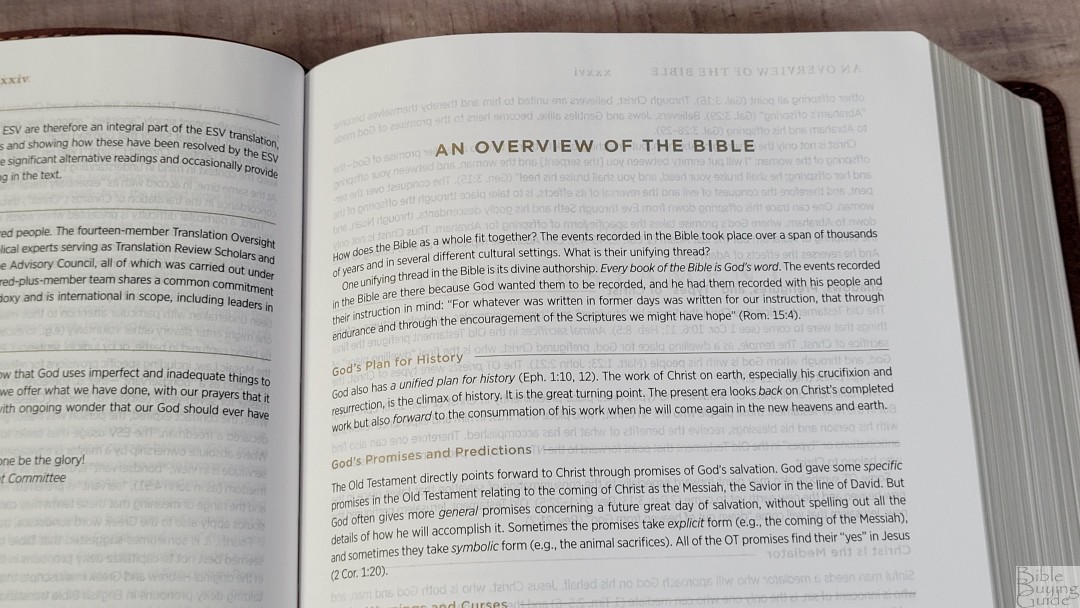
This is a two-page overview that covers:
- God’s plan for history
- Promises and predictions
- Warnings and curses
- Covenant commitments
- Christ the offspring of Abraham
- Shadows and types
- Christ the mediator
Old and New Testament Introductions
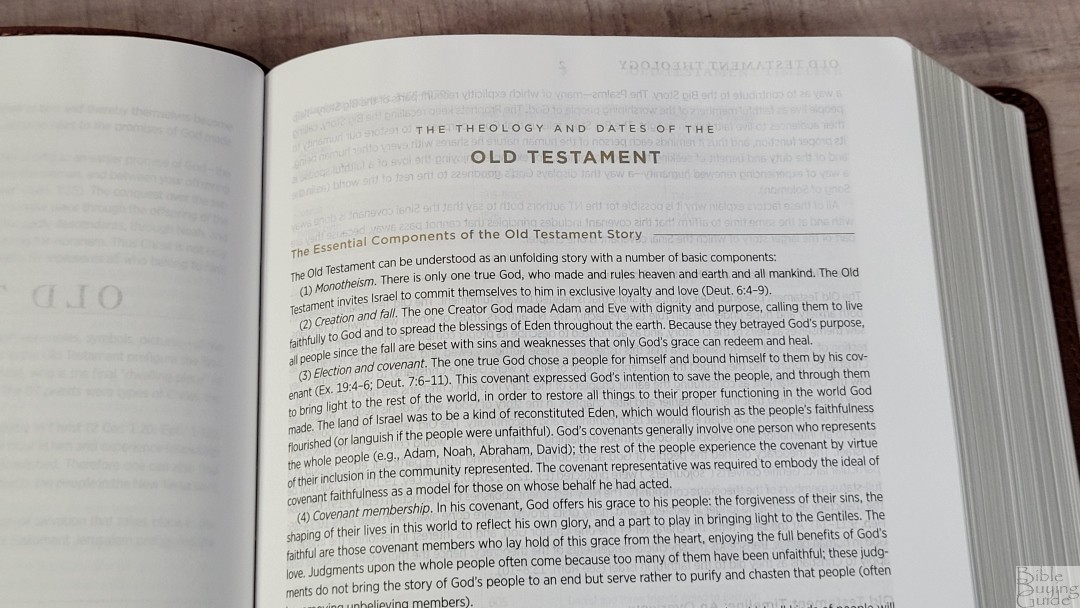
The OT is 4 pages and includes paragraphs and tables that cover:
- The essential components of the OT story
- The parts of the OT in relation to that story
- The OT as Christian Scripture
- OT timeline (with chart)
- The Hebrew Calendar compared to the Gregorian calendar (with table)
The NT introduction takes 4 pages and includes:
- Already but not yet,
- Who is Jesus?
- Christ’s work on the cross
- The promise of the Holy Spirit
- Sin, faith, and repentance
- The Church as the people of God
- NT timeline (with chart)
Bible Books
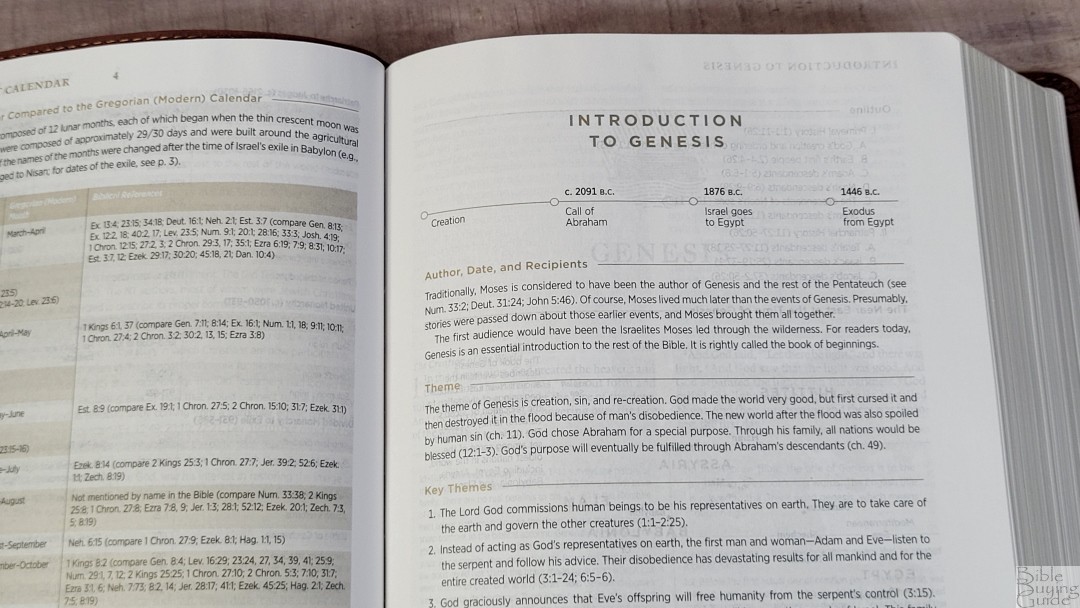
Individual book introductions take a page or two. Each one is unique, but they include elements such as:
- Timeline
- Author, date, and recipients
- Theme
- Key themes
- Outline
- Map
- Structure
Study Material
Many of the notes are from the ESV Study Bible, but they’ve been shortened by half to focus on the key points. These include illustrations as well. The study material includes over 12,000 theologically rich study notes, 120 character profiles, and 900 key biblical facts. All the charts and illustrations follow the same tan colors as the ESV Study Bible.
Reflections
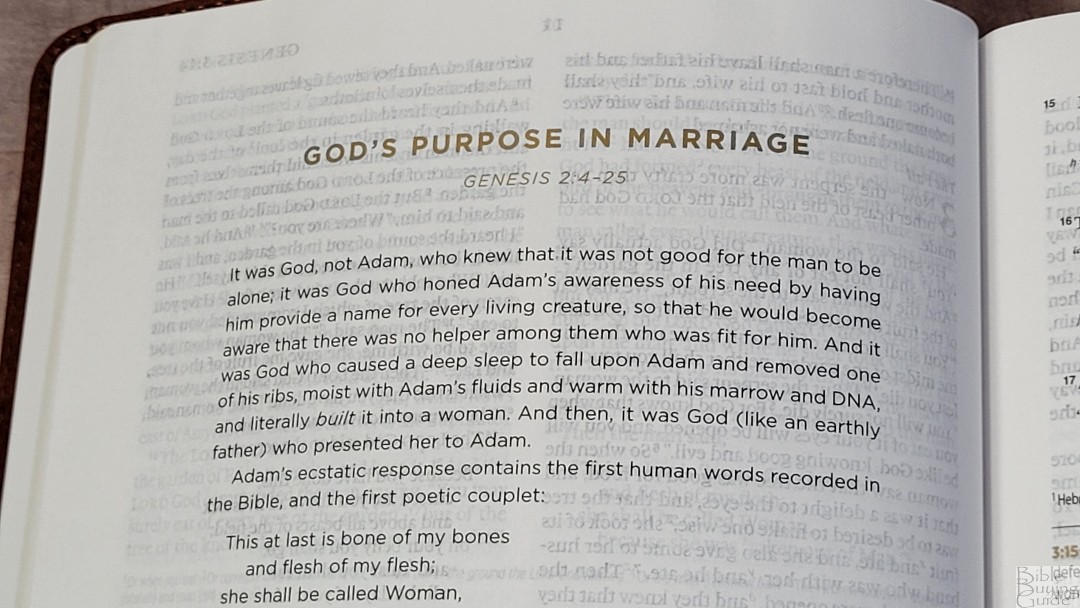
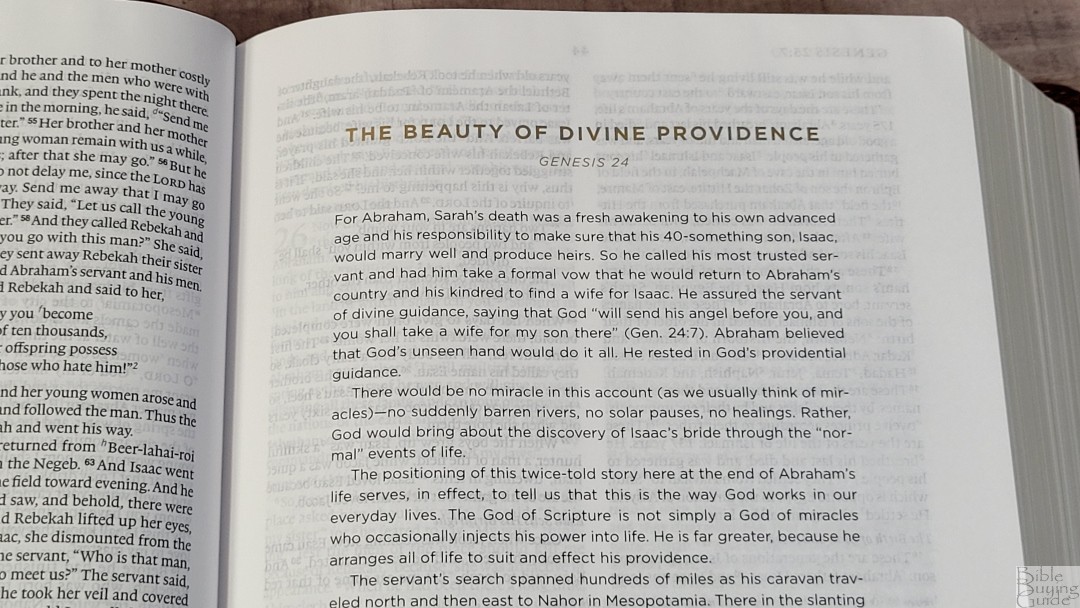
These are short articles on many topics. They take less than a page and they’re placed on a page by themselves. There are over 300 of them throughout the Bible. They’re the daily devotionals from the Men’s Devotional Bible, but they don’t show a date or show which devotional is next. So, they’re meant to be used as articles rather than daily devotions.
Commentary
The Commentary at the bottom of the page also includes notes, charts, profiles, and illustrations.
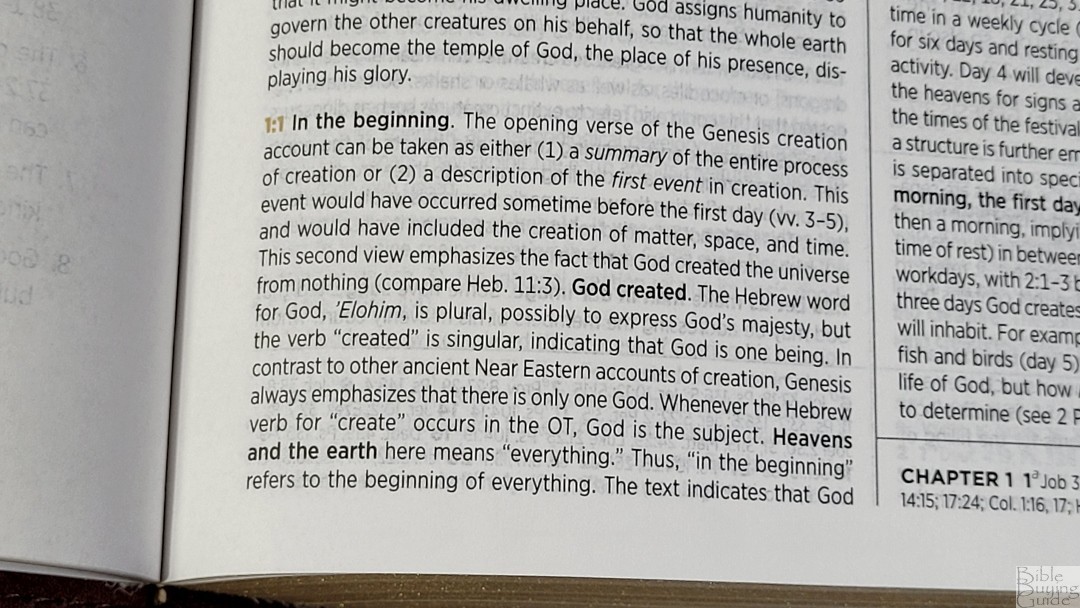
Textual Notes – this is commentary from the ESV Study Bible. It doesn’t include all the commentary or cover all the verses. Instead, it includes the most important notes.
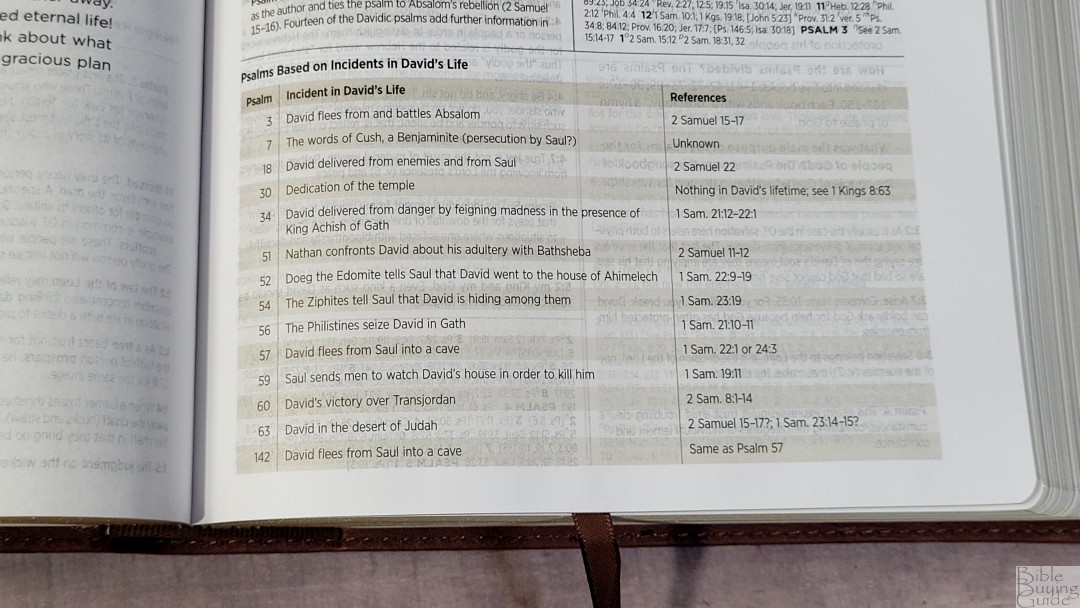
Charts – these are small charts and tables within the notes.
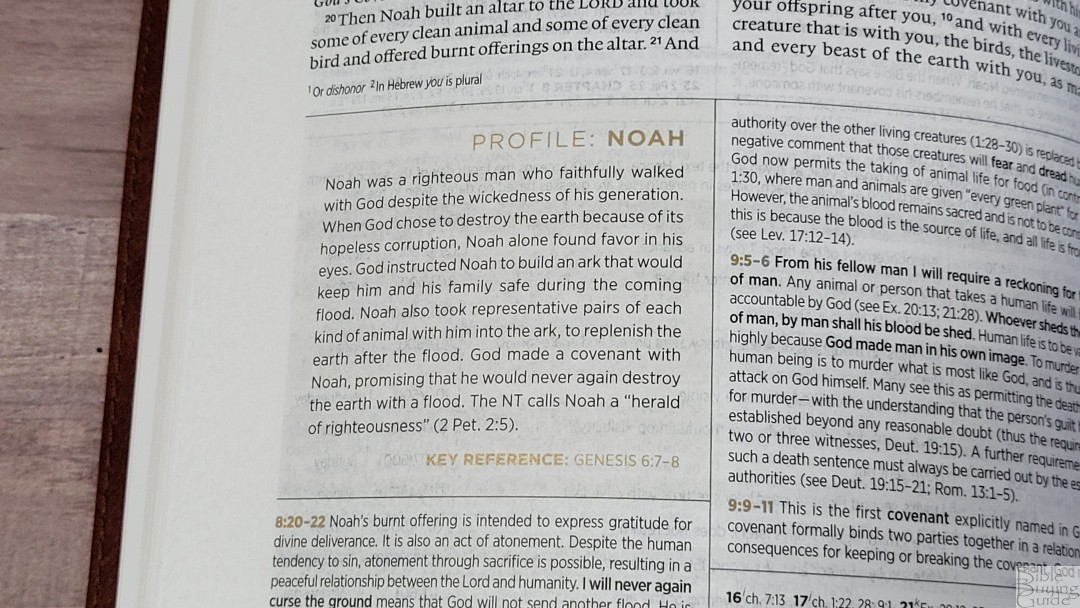
Profiles – these are biographies. They’re placed within the notes and include a paragraph about an individual. They include a key reference for each person.
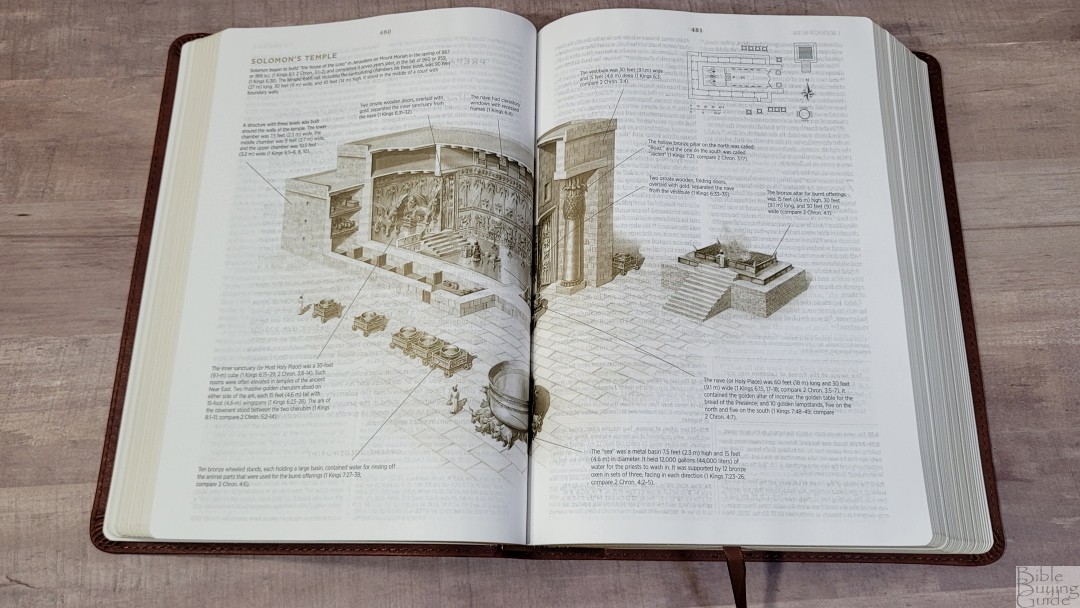
Illustrations – these are drawing from the ESV Study Bible. They include temples and other structures.
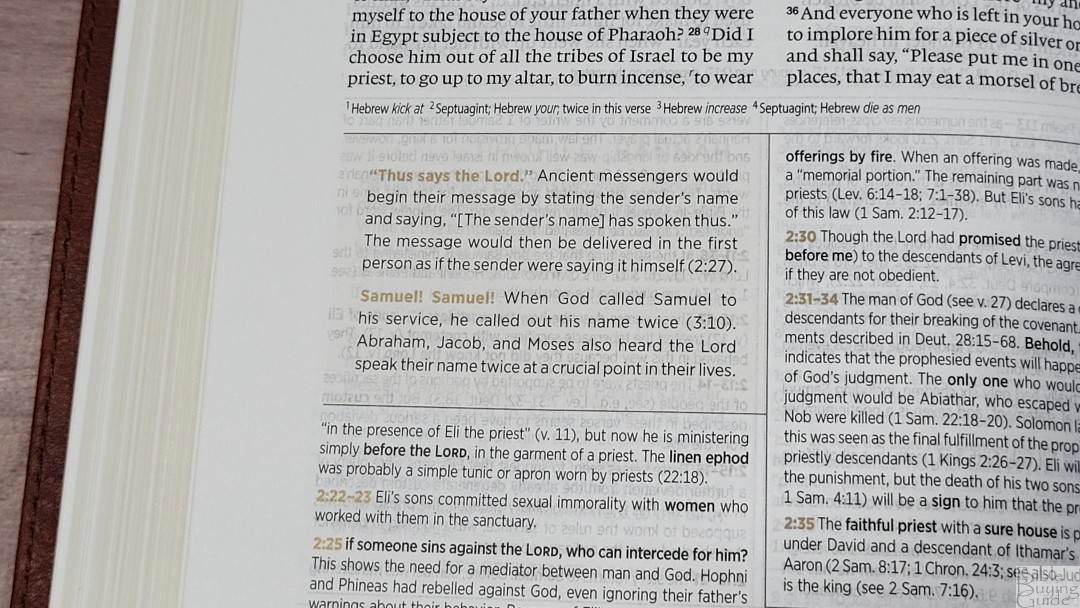
Facts and Observations – these are highlighted notes that cover points in the text. There are lots of them throughout the Bible.
Articles
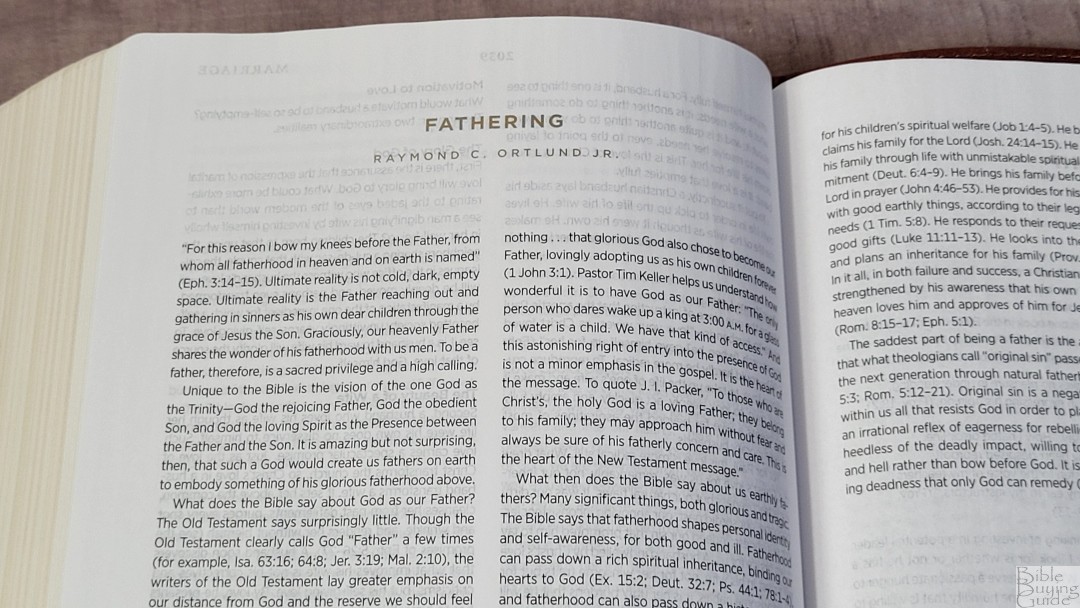
There are 15 articles in the back that are designed to help men get closer to God and build their relationships with their wives, children, and Church. These are the same articles as found in the Men’s Devotional Bible, but with one new one.
Articles include:
- God’s Plan of Salvation
- The Message of the Bible
- A Man’s Identity
- Communion with God
- The Gospel and Daily Life
- A Man’s Inner Life
- Life in the Local Church
- Calling
- A Man’s Work
- Singleness
- Marriage
- Fathering
- Leadership
- Pornography
- Doubt
Glossary
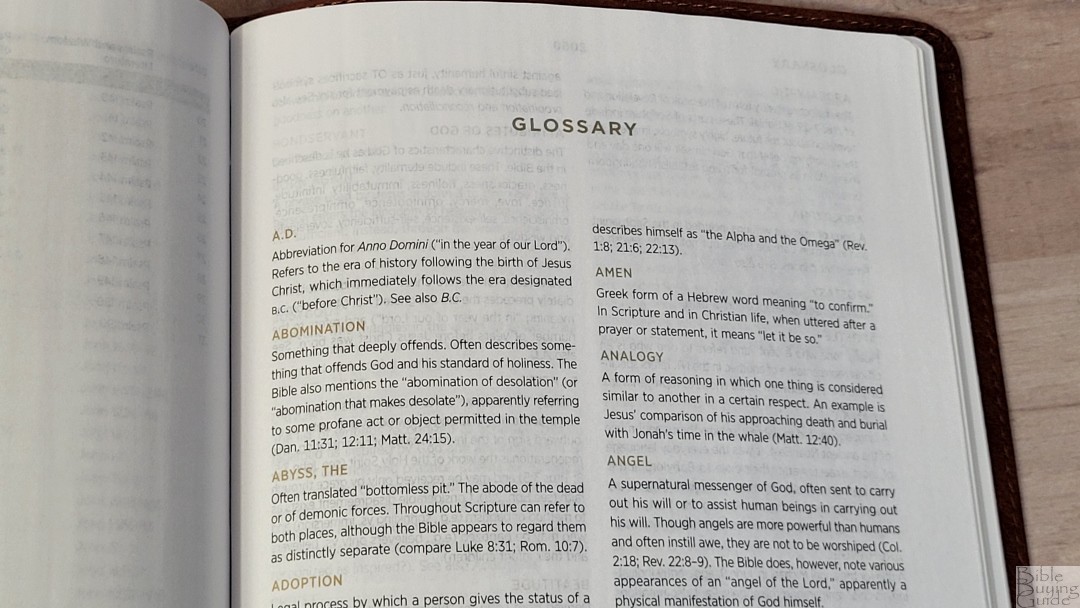
The glossary is 15 pages with over 300 entries that cover the key Biblical words. This includes a lot of theological terms and it does include some theological bias. This is a good tool to help in your own study.
Reading Plan
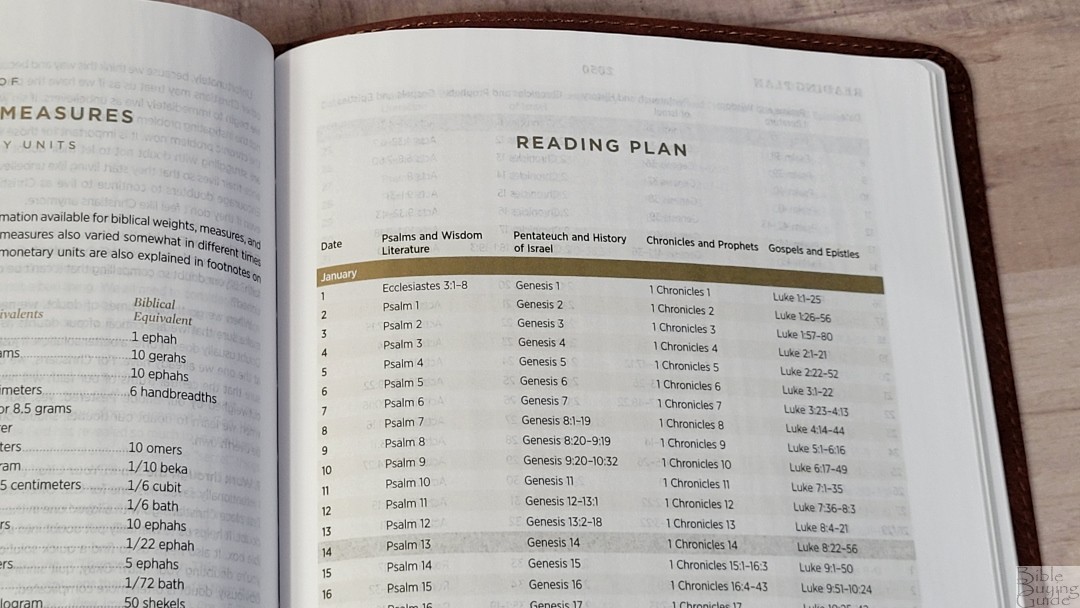
The reading plan divides each day into 4 readings to give you:
- Psalms and Wisdom Literature
- Pentateuch and history of Israel
- Chronicles and Prophets
- Gospels and Epistles
This is an interesting reading plan as it gives you readings from different types of literature and biblical genres. I’d also like to see a standard plan for those who prefer not to read from multiple places at once.
List of Reflections
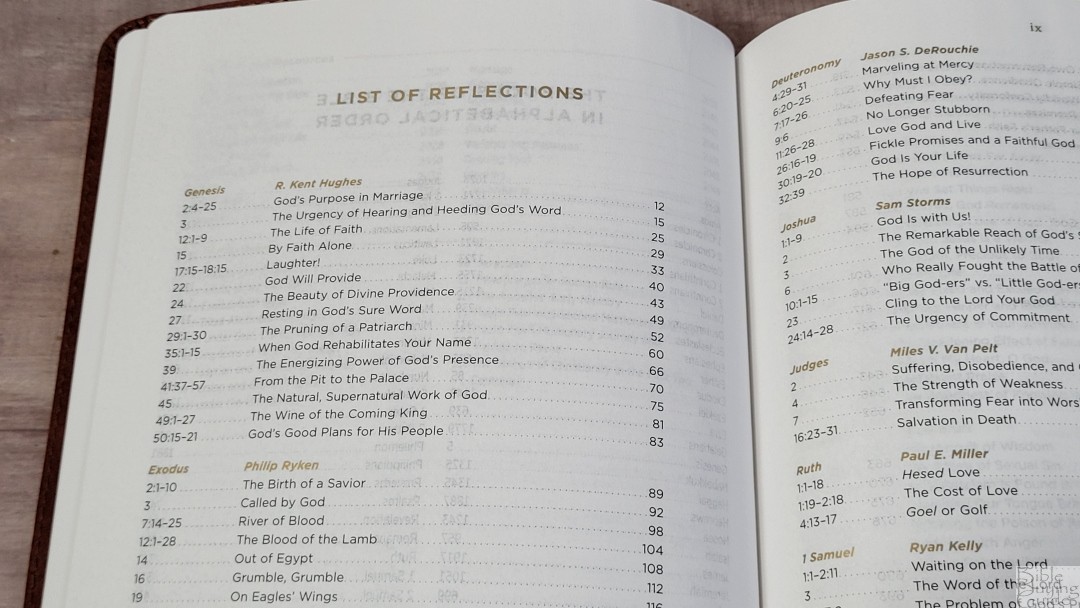
This is an index in the front with just over 10 pages and sorts the reflections by book and author. It gives the reference, title, and page number. This makes it easy to find any reflection by any author.
List of Charts, Profiles, and Illustrations
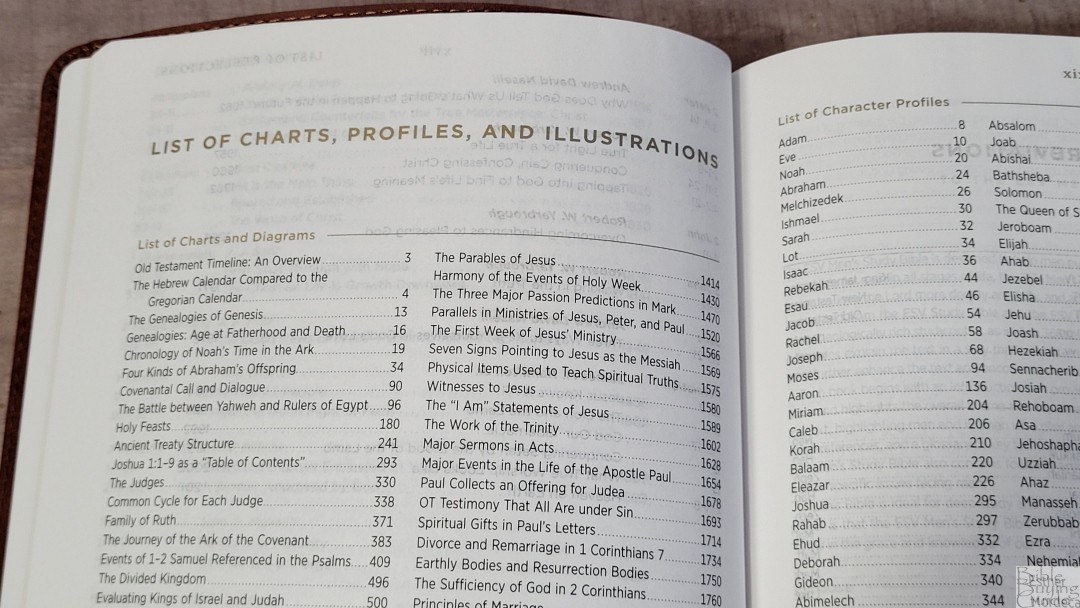
This is an index in the front with 2 pages that divides the topics into three sections: charts and diagrams, character profiles, and illustrations. You can look up anything by name and see the page number.
Concordance
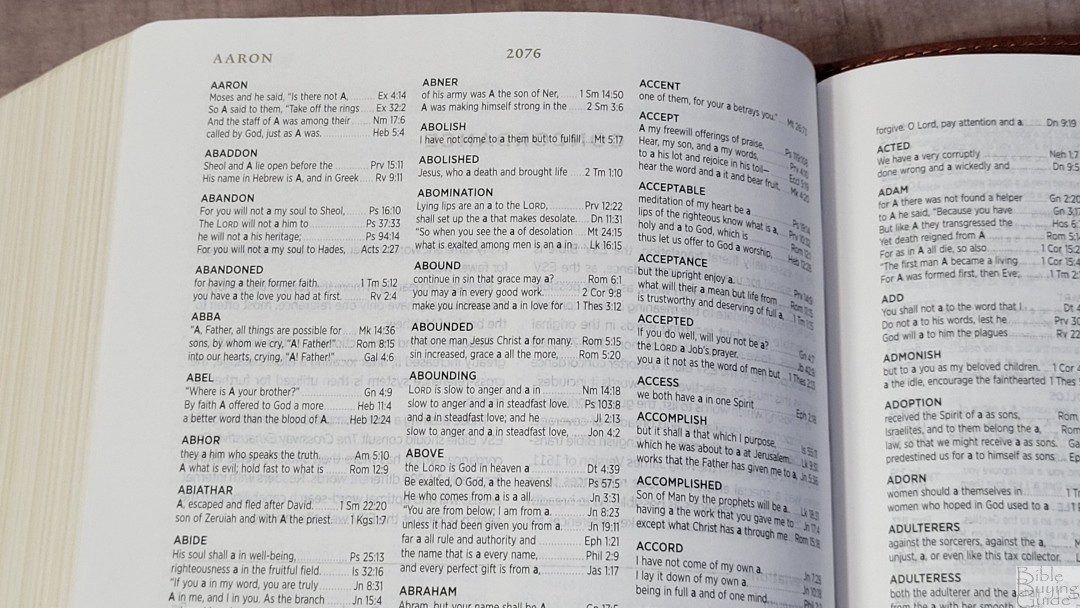
This is a large concordance with 62 pages and 3 columns per page. It includes proper names of the most prominent people and places. This is a good concordance for personal study and sermon prep.
Sample entries include:
- Christ – 16
- Christ’s – 4
- Christian – 2
- Faith – 28
- Faithful – 10
- Faithfulness – 6
- Faithless – 1
- God – 49
- Godliness – 4
- Godly – 3
- Gods – 2
- Praise – 19
- Praised – 2
- Praises – 2
- Pray – 11
- Prayer – 10
- Prayers – 6
- Praying – 3
Maps

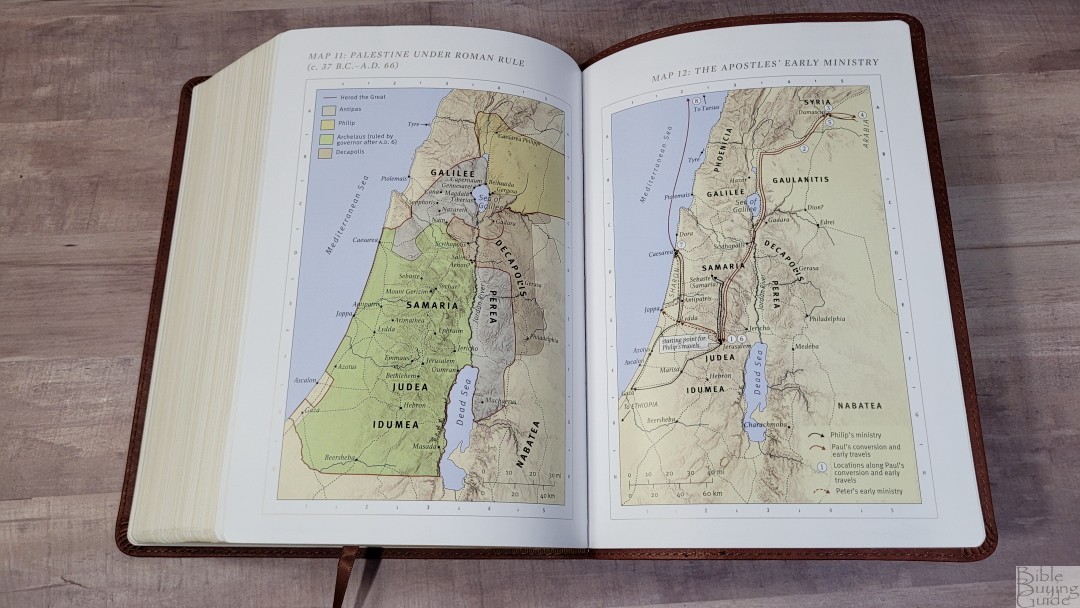
In the back are the 15 Crossway maps printed on thick semi-glossy paper. The maps are printed with earth-tone colors and include distance, topography, borders, routes, rivers, kingdoms, etc. It doesn’t have an index to maps, but they are labeled well. I find them easy to use.
Maps include:
- The Middle East Today
- The World of the Patriarchs
- The Exodus from Egypt
- The Tribal Allotments of Israel
- Israel Under Saul, David, and Solomon
- The Kingdoms of Israel and Judah
- The Assyrian and Babylonian Empires
- The Persian and Greek Empires
- Isreal Uner the Maccabees
- Jerusalem
- Palestine Under Roman Rule
- The Apostle’s Early Ministry
- Paul’s First and Second Missionary Journeys
- Paul’s Third Missionary Journey and His Voyage to Rome
- The Spread of Christianity in the First Two Centuries
Conclusion
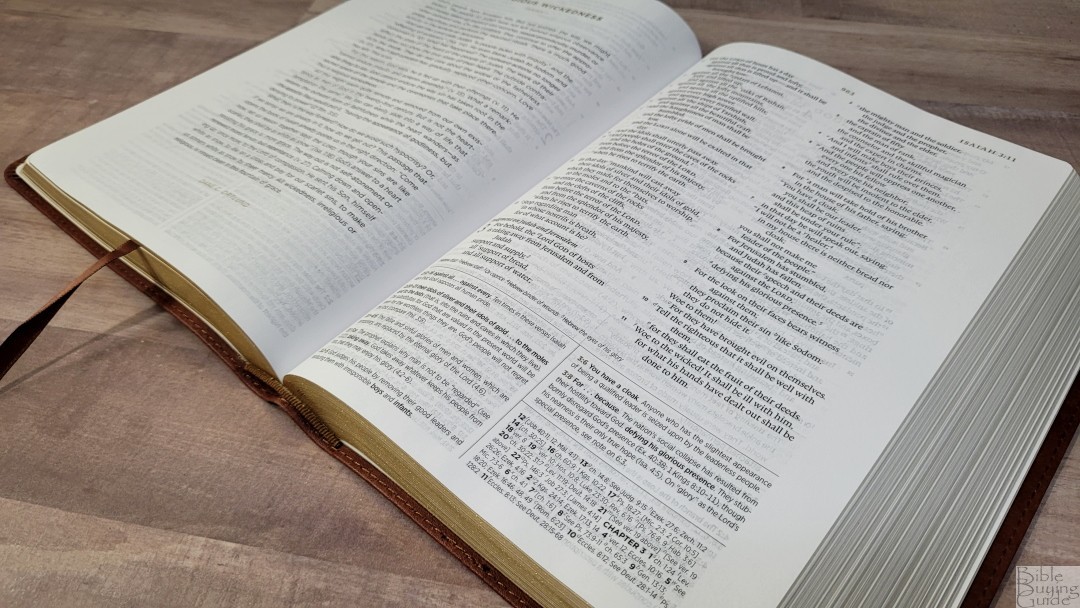
The ESV Men’s Study Bible is very much a hybrid. It’s a little bit of the ESV Study Bible meshed with the ESV Men’s Devotional Bible. This does create an interesting study Bible with a lot of information that men will find helpful, but it’s not entirely focused on men’s studies. It does include the content from the Devotional Bible, but only a reduced portion of the ESV Study Bible. This means if you use the ESV Study Bible then you don’t need half the content. If you need the ESV Study Bible content, then you’ll miss a lot of it in this Bible. I think it would have been better with more focused content. If you already have the ESV Study Bible and the Men’s Devotional Bible, then you only need this one if you want them combined. If you want this type of hybrid, then the ESV Men’s Study Bible is an excellent choice.
_________________________________________________________
This Bible is available at (includes some affiliate links)
and many local Bible bookstores
_________________________________________________________
Crossway provided this Bible in exchange for an honest review. I was not required to give a positive review, only an honest one. All opinions are my own.


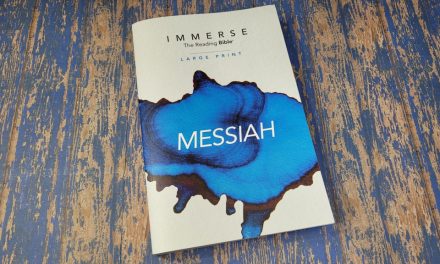
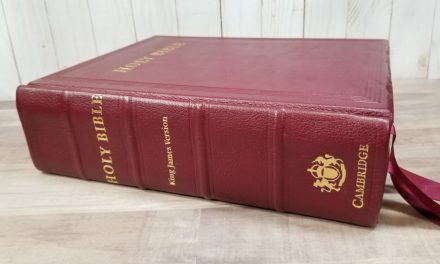
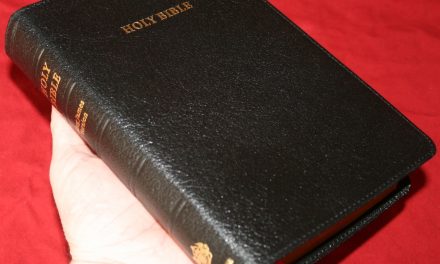
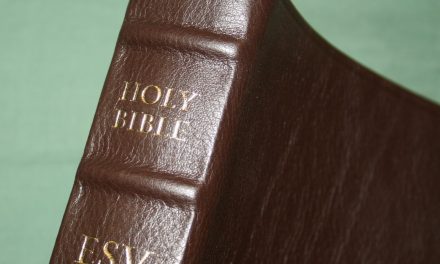





Would like to know if this is a Red Lettering Bible, thanks!